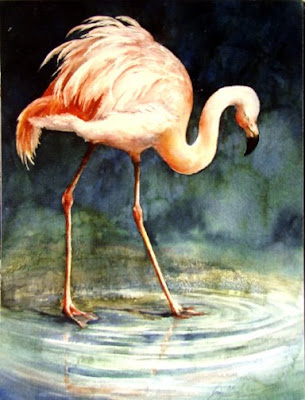 Rhonda Carpenter's newest paintings of flamingos shows how well she incorporates various hot colors to define the birds - see her blog here. Many, many, many moons ago, I painted this fancy flamingo as a class demo to show how to achieve the look of feathers as well as how to make the most of contrast.
Rhonda Carpenter's newest paintings of flamingos shows how well she incorporates various hot colors to define the birds - see her blog here. Many, many, many moons ago, I painted this fancy flamingo as a class demo to show how to achieve the look of feathers as well as how to make the most of contrast. Planning ahead to allow the darkest darks to be next to the lightest lights in a painting is one of the easiest ways to make a stronger focal point to draw the eye. Hard edges also get the most attention - compared to soft or lost edges, as do diagonal lines, compared to horizontal or vertical ones.
Small shapes make the eye stop and look. Strong color temperature change - warm vs. cool - is another effective tool to incorporate in the focal area. Even using pure colors next to slightly grayed ones makes the pure color get much more attention.
Any type of contrast always makes us notice and keeps our interest. It's fun to take advantage of that principle to make a painting more effective, more exciting for the viewer to look at.
"STRUTTING HER STUFF" Transparent Watercolor on 140#CP Arches 13 x 20" COLLECTED




